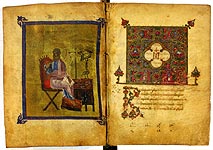Tetraevangelion.
10th cent. (third quarter). Constantinople, Imperial Skriptorium (?)
O (156 ı 113). I+259+I leaves. Both the beggining and the end are missing.
Parchment, purple parchment (fols. 124r-125v, 201r-202v). Ink, colours, gold, silver.
It is written in a small calligraphic minuscule hand.
There are 4 full page miniatures (fols. 2v, 79v, 123v, 200v), 4 multicolour ornamental head-pieces on a gold background (fols. 3r, 80r, 124r, 201r) and 5 initials (fols. 124r-125v). The text is written, mainly, in silver, the text on folios 3r-3v, 80r-81v, 201r-202v is in gold.
The miniature Tetraevangelion was copied onto thin parchment in an exquisite minuscule script. Books of very small size were particularly popular with the Byzantine society, the majority of them were produced by teams of highly skilled scribes and artists working in the Imperial Scriptorium. However, this manuscript has no records of the date of its creation and its place of origin. Miniatures show the features of the artistic style, developed by the third quarter of the 10th century and, generally, characteristic of works of the Imperial Scriptorium. They are remarkable for the fineness and the elegance of their workmanship. The classical harmony of forms, features and gestures reflects spiritual lives of images, which are distinguished from the rather extensive artistic heritage of book-painting dating from the third quarter of the 10th century.
20 leaves from this manuscript are now held in the Manuscripts Department of the Russian State Library (Ù. 17, no. 1238). In 1867 they were received by Elpidiphor Barsov from Petrozavodsk, and later went into the Rumiantsev Museum (»ÌÓÒÚ. 369).
The main part of the codex came into the State Public Library in 1929 from the State Russian Museum, where it, for its turn, was transferred in 1928 from the St Petersburg City Museum, housed inside the Anichkov Palace, Π9680).
Shelfmark: –Õ¡. √˜. 801.





